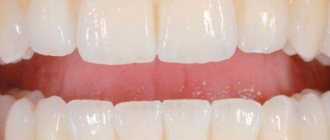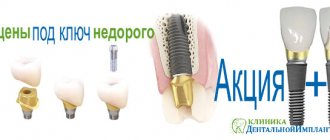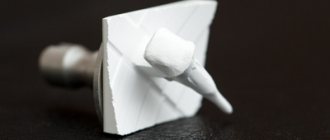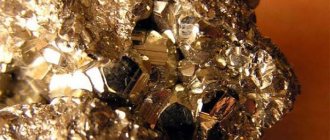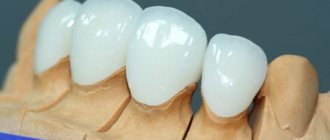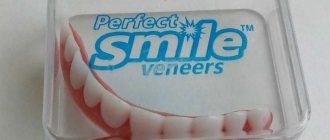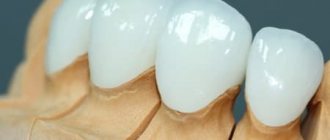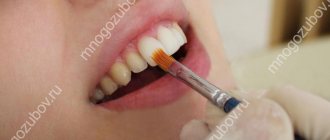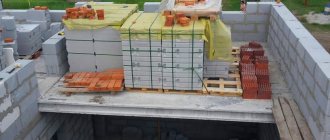What are zirconium dioxide veneers and their features
Veneers are permanent microprostheses in the form of overlays that are fixed on the front surface of the teeth and hide chips, enamel damage, and color irregularities. Zirconium onlays, or rather, those created from zirconium dioxide (it is obtained by chemical and thermal treatment of natural zirconium compounds). Zirconium veneers (although it is correct to say “dioxide”, and not just zircon or zirconium) are characterized by increased strength and high aesthetics (see photo) and reliable adhesion to the surface of the teeth.The service life of zirconium dioxide veneers is 2-3 times longer than that of conventional ceramic ones.
Zirconium dioxide is very durable (exceeds metal in strength, but is 2 times lighter) and lends itself well to modern processing methods - so microprostheses are very thin. Despite this, due to their low transparency, they do not allow the original color imperfections of the teeth to pass through. For example, if there are dark spots.
Pros and cons of zirconium veneers
It is no coincidence that zirconium veneers are increasingly used by dentists today. They have a number of obvious advantages, but there are also disadvantages.
- Durability, ability to withstand heavy chewing load.
- Consistency of shade under different lighting, including ultraviolet.
- The materials of zirconium veneers are biocompatible with human tissues, do not cause rejection or allergies, the body perceives them as its own tissues.
- Resistant to dyes, including tea and coffee.
- Possibility of use in complex clinical cases.
- Resistant to sudden temperature changes (protection for sensitive teeth).
- The procedure takes longer because the material is difficult to fix on the tooth surface.
- Installation requires significant tooth grinding. Once the plates are installed, it will no longer be possible to return the teeth to their original state.
- The price of zirconium veneers is quite high, which is due to the complexity of the procedure and the use of expensive equipment.
Indications for use
- chipped enamel, cracks in teeth,
- spaces between front teeth,
- increased abrasion of enamel,
- complex color changes in enamel: stains and yellowing, fluorosis, “tetracycline” teeth, and in cases where whitening does not produce visible results,
- mild curvature of teeth,
- weak, sensitive or underdeveloped tooth enamel.
Unlike all-ceramic or porcelain, microprostheses made of zirconium dioxide can be used even in the most complex clinical cases. For example, when the teeth “look” at each other, are slightly rotated around their axis, there are very large gaps, or the color of the enamel is changed so much that it can even show through the ceramic.
Indications for installation of veneers
Veneers solve patients’ aesthetic problems. Their task is to provide perfectly straight teeth, a beautiful “Hollywood” smile, and an attractive appearance. Therefore, indications for veneering include external imperfections - and only the front teeth.
Ceramic and composite onlays are recommended if a person has:
- chips and cracks on the incisors and canines - unaesthetic minor damage that allows the teeth to be used as a support for enamel-colored overlays;
- interdental gaps (trema, diastema) - significant gaps between the incisors, uncorrected by the orthodontist;
- heterogeneity of tooth enamel in color - white spots, yellow or dark stripes that occur as a result of fluorosis or due to taking a number of medications;
- darkening of the tooth after treatment - removal of the pulp leads to loss of natural whiteness, distinguishes the filled tooth from other units;
- multiple fillings - as a result of frequent treatment of the front teeth;
- orthodontic problems - crowded teeth, dislocated or rotated teeth;
- lack of results when whitening teeth enamel - including the best modern Zoom techniques.
Aesthetic restoration is usually carried out in a comprehensive manner, involving the front teeth of one row or both dental rows at once.
Contraindications for wearing
The dentist may refuse to install veneers on the patient if there is a large amount of tartar and plaque on the teeth (they need to be removed first) or if it is impossible to carry out thorough oral care. If a person has caries, stomatitis or gingivitis, or old fillings (in need of replacement), then these problems must first be solved.
Any microprosthesis needs good support, so veneers are not installed if the top of the tooth is chipped by more than 50%, or there are very large fillings on it.
An absolute contraindication would be the presence of chronic periodontitis or periodontal disease, accompanied by gum loss, loose teeth, and prolonged inflammatory processes. If serious curvatures of the dentition, displacement, or bruxism are detected, then zirconium onlays cannot be installed here either, because You should first undergo treatment from an orthodontist (and a neurologist for bruxism).
What are crowns?
Dental crowns are permanent prostheses that cover the part of the tooth protruding above the gum completely from all sides. When severe damage occurs, there is simply no alternative. This is despite the fact that not only the appearance, but also the full functionality of the tooth is restored to its original level.
To install a crown, it requires support, which is usually the top of the tooth. If this is not the case, then pins are installed in the root or a stump base is formed. This allows you to secure the crown. When there is no root at all, an implant is first placed.
There are several materials used for manufacturing: metal, ceramics, plastic, all kinds of combinations thereof, and, of course, zirconium is considered one of the best.
Indications for the use of zirconium crowns are the following aspects:
- restoration of a tooth with a large filling installed on it;
- hard tooth tissues have significant damage that cannot be restored with filling materials;
- pathological abrasion of the enamel is observed;
- there are various anomalies in the structure of the dentition, cracks/chips;
- the interdental space worsens the aesthetic appearance of the dentition;
- There are contraindications for dental restoration with veneers, etc.
There are also contraindications for installing crowns, and their list looks like this:
- allergic reaction to materials;
- tooth mobility at the pathological level;
- low height of the residual part, which does not allow installation of the product;
- thin layer of enamel;
- periodontal tissue disease, etc.
Advantages and disadvantages
The benefits of zirconium veneers are as follows:
- aesthetics - at the highest level and for a very long time: the color and shape of the overlays are preserved, and they are also resistant to stress and food coloring,
- perfect fit to the tooth and gum: the absence of micro-gaps eliminates the risk of microbial penetration,
- minimal thickness, can often be placed on teeth without grinding, especially if dioxide is used in its pure form - without ceramic coating,
- material strength and tooth protection: zirconium onlays can withstand high and low temperatures, acids and alkalis. They also prevent chipping because they grip the cutting edge of the tooth,
- hypoallergenic material,
- antagonist teeth are not injured: zirconium dioxide is more flexible compared to metal (which often serves as the basis for artificial crowns and is lined with ceramics),
- the ability to quickly correct defects without braces,
- the ability to restore either 1 tooth or 6-8 at once.
Don't know what type of prosthetics to choose?
We will help in the selection, advise where to read more information and compare types of prosthetics.
Consultation with an orthopedic doctor in Moscow clinics is free! Call now or request a call
Working hours: from 9:00 to 21:00 - seven days a week
Like any other microprostheses, zirconium veneers have disadvantages:
- need enamel turning,
- Zirconium dioxide is usually white in color without obvious translucency: this is true for most manufacturers. But the most progressive companies have learned to make translucent zirconium blocks, painted in natural shades, • high cost, • the need for careful handling, • specialized equipment is required for the production of zirconium onlays, • not suitable for all patients due to contraindications.
Very often, to make veneers even more natural, specialists coat the milled zirconium dioxide base with ceramic materials that have the highest aesthetics and light refraction.
How veneers are installed on teeth: direct and indirect methods
How are veneers placed on teeth? The method of fixation depends on the material:
- Direct method. Used only for composite restorations directly on teeth. The doctor prepares the tooth by grinding and applies the filling compound in layers, forming the surface of the tooth. After hardening, grinding and polishing are carried out to completely duplicate the enamel in color and structure.
- Indirect method. Suitable for all laboratory-produced veneers, it requires certain preparatory work, as well as the experience of the doctor.
Manufacturing features and installation steps
Zirconium dioxide veneers have their own peculiarity - they are created by an indirect method. That is, in laboratory conditions, but not manually, but through automated, fully robotic milling equipment - CAD/CAM systems. Thus, the treatment process will look like this:
- preparing teeth: cleaning from plaque and stone, removing carious cavities, removing part of the enamel from the front, bottom and side areas - this is necessary so that the linings are securely fixed and do not “stick out” beyond the row. Also, for better adhesion to the microprosthesis, shallow grooves are made on the tooth surface,
- Oral scanning (or taking impressions): This is done using an intraoral 3D scanner or regular wax impressions. Casts are used to make a model and scan it directly in the laboratory. The data is loaded into a computer, where the shape and color of the prostheses are modeled (CAD technology). At this stage, the patient can familiarize himself with the future result of the treatment and express wishes regarding color/shape,
- creating veneers from a single piece of zirconium: it is impossible to process the material manually and achieve perfect accuracy. Therefore, a special computerized apparatus is used, equipped with durable cutters (CAM technology). The final adjustment, and if an additional layer of ceramic is required, is carried out by a dental technician.
- fitting and fixation: microprostheses are glued first with temporary glue, and then with a permanent, durable adhesive composition. To make sure that a person’s smile is radically changing for the better, you can look at the photos before and after installing zirconium veneers.
In general, the process of making permanent veneers takes about 1-2 weeks maximum - from the moment of preparatory work to the actual prosthetics. While manufacturing is underway, the patient wears temporary plastic onlays - which are installed after turning and taking impressions (scanning). Temporary veneering ensures the safety of the ground stump - from infection, hot food and chips, and also leaves a person’s smile attractive.
Features of care
After installation, most patients are very worried about the length of the adjustment period. It should be noted that such a process does not take much time; after 7 days a person ceases to feel the presence of foreign bodies. In most cases, complete adaptation occurs after two to three weeks.
In order for the quality of veneers to please you for many years, it is necessary to carry out regular and high-quality hygiene of the gums and teeth, carry out preventive professional teeth cleaning on time, and remove dental deposits.
Veneers are thin shells that are firmly fixed to the teeth, but it is very unwise to test this strength. That is why it is important that all dental units in the oral cavity are healthy and can fully function. If teeth are missing, you need to think about the implantation procedure, otherwise the front incisors with veneers will be subject to stress. As a result, there is a risk of product breakdowns.
It is recommended to carry out treatment, restoration and prosthetics of teeth in one clinic. Thus, a person can be sure that a team of specialists is focused on a common result. With regular visits to the dental clinic, any damage will be detected in time and the patient will receive timely help.
Popular brands of materials
The veneers themselves can be created from a single block of zirconium dioxide (Prettau brands from Zirconia Zirkonzahn or IPS e.max from Ivoclar Vivadent). Or, as already mentioned, to have an external ceramic coating (lining and pressing) - this depends on the manufacturing technology. In the first case, microprostheses are more reliable, since there is no risk of chipping the ceramic enamel.
One of the modern materials for cladding is glass ceramics or lithium disilicate, which has the strength of zirconium and the aesthetics of ceramics. Innovative transparent adhesives based on glass ceramics are used as the adhesive used to fix the onlay to the tooth.
Complex on 4 OSSTEM implants with delayed loading - from RUB 170,000.
Complex implantation Osstem (South Korea) with delayed loading after 4-6 months.
Guarantee for the doctor’s work - unlimited Call now or order a call
Opening hours: 24 hours a day - seven days a week
Veneers in ART dentistry: benefits of treatment
The ART dental clinic in Odintsovo offers the installation of veneers using direct and indirect methods, the production of plates from ceramics, zirconium dioxide, and the creation of composite onlays. Each patient of the aesthetic dentistry department expects:
- Thorough consultation with a doctor. An experienced, highly qualified orthopedist will tell you everything about veneers - the pros and cons of the procedure, how the veneers are attached. He will answer any questions you may have and select material.
- Modern equipment and the best formulations - dentistry works with products from leading dental companies. Offers aesthetic restoration with Emax Ivoclar Vivadent, Noritake (Japan) products.
- Providing all services in one place - caries treatment, the patient’s oral hygiene will be carried out in the clinic.
- Psychological comfort - in dentistry, ART successfully works with all patients, creating trusting relationships and a friendly atmosphere.
- Affordable cost of the service - prices for veneers in Odintsovo are reasonable and can be easily selected for any task.
How to properly care and wear
In order for your smile to remain attractive and snow-white, you must not forget about the rules of wearing and caring for the overlays. Although zirconium is very durable, it can still break or come off the tooth if pressed hard. Therefore, orthopedists do not recommend biting off pieces of hard food (a piece of meat, raw fruits/vegetables) - only cutting them into small portions first. You should also not chew pencils, nuts, crackers, seeds, etc.
You need to clean the restorations with a brush and paste twice a day, rinse your mouth after eating - everything as usual. But paste with abrasive particles or very hard brush bristles can scratch the ceramic veneer or gums. Another important condition that many people forget about is regular visits to your dentist (2 times a year for prevention). After all, it is easier to identify any problems at an early stage than to deal with them for a long time later.
Are veneers harmful to teeth?
Before installing veneers, the doctor will definitely tell you about all the nuances of microprosthetics and warn about the consequences. It is important for the patient to understand that:
- Fixing the onlay requires mandatory preliminary preparation of the enamel. The procedure is irreversible, so if you want to remove the veneers, you will have to consider an alternative option for aesthetic restoration.
- There will be some dietary restrictions. After installing veneers, the patient will have to give up “bright” foods and drinks, reduce the frequency of smoking if they have such a habit, and learn to chew food with their chewing teeth rather than their incisors.
Like any correction, veneering is done according to indications, when the benefits of treatment outweigh other factors.
How zirconium differs from other microprostheses
The fundamental differences between zirconium veneers and classic ceramic ones1 are as follows:
- manufacturing process: it is more complex, but at the same time precise, which makes it possible to achieve almost ideal positioning of microprostheses on the teeth. They fit tightly, food residues do not get clogged into microcracks, which means there is no risk of developing caries under dentures.
- Zirconium dioxide is a very durable material: microprostheses are thinner during processing (therefore, the enamel is ground down very little) and are very resistant to stress.
%akc72%
If we consider the differences from lumineers, then you need to know that these thinnest veneers are created using secret technologies in the CERINATE company. Production is carried out only in a laboratory located in the USA, and the exact composition of the material is also unknown. If a person wants lumineers, then the orthopedist will only prepare the teeth (grinding is almost never required here) and take impressions, which will be sent to the manufacturer by plane. Lumineers last longer than zirconium microprostheses.
Veneers: how to install them step by step
Interested patients are often recommended to watch “how veneers are placed” on video. The information in such videos is reliable, but limited. The demonstration covers the technique, but omits the preliminary preparation step.
Installing a veneer using the direct method is a fairly time-consuming process. The doctor is required to be thorough and thorough at every step of treatment. Fixing the lining is:
- Preliminary inspection. The orthopedist evaluates the possibility of microprosthetics and chooses a method of aesthetic dental restoration. To do this, during the examination, the doctor identifies the presence of problems with the bite, clarifies about bruxism, studies the position of the teeth and the condition of the enamel. Based on the diagnostic results, he recommends the material and manufacturer of veneers.
- Preparation of the oral cavity - teeth are treated for caries and pulpitis, and surfaces are completely cleaned. The doctor prescribes the removal of plaque and tartar, and selects therapy if necessary to eliminate inflammatory processes.
- Obtaining an initial cast of the jaw and computer modeling of the desired result.
- Preparation of the enamel of selected teeth under local anesthesia - creating the basis for the installation of plates.
- Repeated impression taking - to send to the laboratory for the production of ceramic or zirconium veneers.
- Fastening temporary teeth before installing permanent veneers. Temporary overlays are made of plastic. Their task is to protect teeth without enamel from injury.
- Fixing the onlays for permanent wear - the plates are attached to a special glue that completely fills the gaps between the veneer and the tooth surface.
Cost of microprostheses made of dioxide
The cost of zirconium veneers both in Moscow and in other cities is relatively high. They are more expensive than porcelain or ceramic onlays, but almost 1.5-2 times cheaper than expensive lumineers (besides, the latter are created abroad and become noticeably more expensive with changes in the foreign exchange market). The price of zirconium dioxide veneers starts from 30 thousand rubles for the restoration of 1 tooth, but it is worth noting that they are stronger, more aesthetically pleasing and more practical than ceramic analogues, so the financial investment is justified in the long term.
- G. Gurel, “Ceramic veneers. Art and Science", 2008
Author: Dulgarov Zh. G. (Thank you for your help in writing the article and the information provided)
Where did composite veneers come from?
To understand which veneers - composite or ceramic - are better, let's delve a little into the history of their creation.
In fact, many years ago, when there were no laboratory conditions, there were no normal technicians or materials, many doctors did direct dental restorations. Just then, the first composite materials appeared, from which so-called composite veneers were made directly in the patient’s mouth, providing the patient with beautiful teeth in one go.
Then, after some time, ceramic veneers began to appear. Composite veneers also began to be made by technicians, which was also beautiful, good and quite cheap, because ceramic teeth were more expensive, the work of technicians was more expensive, their training and the materials for production themselves were also more expensive. Composite onlays became a kind of lifesaver, which made it possible to make the cost of veneers very low.
However, many doctors began to refuse this type of restoration, as they began to notice that after some time ( 5-10 years
) snow-white teeth made with composite began to fade, darken - change color and collapse. The search began for materials that serve patients better and longer.
And, of course, ceramic veneers came to the fore, because composite veneers fade over time, they develop gaps, and cracks appear on them. Personally, I, of course, prefer to give the patient porcelain veneers rather than composite.
Dental veneers are also different, there are many different subtypes, that is, these are classic ceramic veneers, these are zirconium veneers, the so-called lumineers. Ceramic veneers
There are also E-Max and feldspathic ceramic veneers when the veneers are made
using a refractor
.
How much do composite veneers cost?
A composite veneer is a cheaper alternative to ceramic veneers; its price can start at 5,000 rubles per tooth. The average price of a composite in Moscow is from 7 to 10 thousand rubles
. Yes, there is no need to be surprised here, composite veneer is a cheaper version of ceramic veneer, it is more developed in Russian regions, because there is no opportunity to create large laboratories and serious costs for materials.
Therefore, this is, of course, an alternative to ceramics, because it is “both cheap and cheerful.” I don’t do such veneers, since their quality can never be compared with ceramics, and it’s not worth talking about how long they last.
What material are composite veneers made from?
These are special technical composites. Special composites are the same plastic. There are different types of composites - this is what dental restorations are made from. The technical composite provides the patient with a quick, beautiful smile, but over time it fades. In this case, if the doctor does them himself, he must have special skills: be able to polish correctly, be able to give shape.
Is it worth installing veneers that fade over time, crack, or darken so much that they cannot be whitened? - this is a serious issue for dentists today.
Negative sides
The disadvantages of the products include:
- High price.
- Long production time.
- Difficulty in manufacturing due to the need for high precision and the difficulty of fixing the material to the dental organ.
- The need for expensive equipment for the manufacture of structures.
- The need to grind the tooth before installing a microprosthesis.
- Possibility of breakage or peeling if the products are not properly cared for. After peeling off, the veneer can be reinstalled, but if it breaks, it will be necessary to make a new one.
- Once the products have been installed, the teeth will no longer be able to regain their original appearance.
Types of zirconium linings and their manufacturing technology
Previously, zirconium dioxide was used primarily to create the framework of microprostheses, which was then covered with a layer of ceramic. Recently, ready-made plates made from solid blocks of material with a natural shade gradient for better aesthetics have become very popular. This is a more modern option, much more durable and visually more natural.
Since zirconium is very durable, it cannot be processed by hand. Products are literally cut out using computer modeling technologies and automated milling using CAD/CAM technology, that is, on special modern equipment with program control.
Multi-layered technology
In this case, pre-painted blocks are used to create overlays, which gives them a color gradient and the desired degree of translucency. Thus, this technology allows you to create one-piece overlays without ceramic cladding with external characteristics that are as similar as possible to natural enamel. Such veneers have another important advantage - their thickness usually does not exceed 0.4 mm, while overlays created in the traditional way, as a rule, have a thickness of up to 0.8 mm. Obviously, such parameters of the plates require more significant grinding of living dental tissues.
Classic veneers without gradient
This type of zirconium plates involves turning them from solid blocks without gradient or translucency. Such veneers usually have a too bright, immaculate white color, which looks unnatural, and this is a significant disadvantage. To improve aesthetics, only a frame approximately 0.4 mm thick is made from zirconium, and a thin layer of ceramic is applied on top.
But in this case, another nuance arises - due to such lining, the thickness of the final product can reach 0.8 mm, which will entail the need to remove a large amount of living dental tissue. Also, the risk of chipping on the cladding cannot be ruled out. Statistics show that in 10% of cases, the first chips on such linings appear 3-5 years after their installation1.
What are veneers
Many people believe that veneers are something like implants. In fact, veneers are thin shells - plates that are designed to be installed on the front tooth surface to create the appearance of straight, anatomically colored teeth.
The process of fastening products takes place in several stages. As a result, you can not only restore your teeth, but also eliminate problems with color, shape or position. Plates can be placed on one or more teeth. Such dentures do not require complex installation procedures and look natural, creating the desired “Hollywood smile.”
Modern types of veneers can serve as an alternative to dental products such as braces if there are contraindications to their installation. The advantages of dental onlays include elasticity, strength, durability and reliability. On average, depending on the type of product, the warranty period is from 5 to 15 years.
We recommend that you read
Composite veneers
Ceramic veneers
Prosthetics for complete absence of teeth
Types of dental prosthetics
